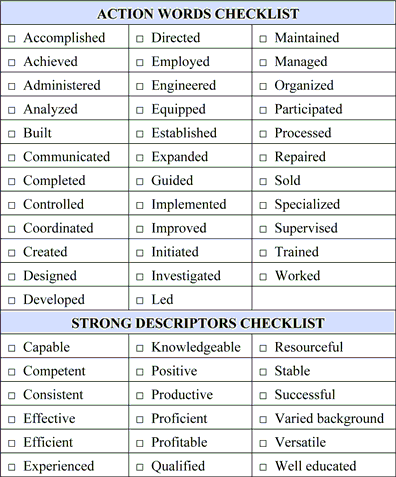Build a Resumé
Create a resumé that demonstrates why you are qualified to operate your business.
A resumé is a concise inventory of your personal experiences, your educational background, and any job-related personal traits. Job seekers prepare resumés to submit to prospective employers, while entrepreneurs use their resumé to support their business plan and proposals. Your resumé outlines what you personally offer to make your business successful. A strong resumé helps you make a good impression and in some cases is the only means of securing a loan or a client, so prepare it carefully.
In making their decisions, lenders and investors place the highest importance on the quality of the manager or management team. A poorly written resumé can detract from an otherwise excellent business plan.
Taking the time to prepare a professional looking resumé will give you a definite edge over your competitors. It indicates a businesslike approach and shows motivation and initiative.

Action Words and Strong Descriptors
Consider the following words when preparing your resumé or completing your application. They will help you make a positive, favorable impression on the reader.

Action
![]()
If you have set up a working copy of your business plan using the Shell™, this information will be entered included in your business plan as an appendices. Place it under Section 6: Appendices sub-heading “Resume.”
Download the Resumé for Entrepreneurs Worksheet
This task list can be carried out using the Resumé Worksheet for Entrepreneurs or by creating a new word document.
- Gather and organize your personal and business contact information, such as your name, address, telephone numbers, fax number, email address, and website address.
- List and prioritize your key strengths according to their importance to the person or team who will receive your resumé. Use the above list of Action Words and Strong Descriptors checklists to help you arrive at a dynamic list of key strengths that sell you, but don’t overdo it.
- Compile a list of your accomplishments. This is optional, as you may choose to simply list your accomplishments under each segment of your work history. Once you have listed your achievements, prioritize them according to their importance to the reader of your resumé or business plan.
- List your past jobs or business experiences, beginning with the most recent and working your way backwards in time. For each listing, include dates or number of years of the engagement, your job title, name of the organization, and a list of the most relevant skills, accomplishments, and duties. You can pick and choose the parts of your work history that are most relevant to the reader of your resumé.
- List your educational and training achievements, beginning with the most recent and working your way back in time. If this segment is more important to the reader of your resumé, feel free to place it before the work history.
- Briefly list your interests. Your objective with this is to reflect that you have a life, but not so much of a life that you’re too busy to work. Use this segment to reflect aspects of your life or personality that are not obvious in other parts of your resumé. For example, fitness, community involvement, volunteering, hobbies, etc. This segment is optional.
- Compile a list of references and either include them at the end of your resumé or state that references are available upon request. In all cases, be sure to ask permission of anyone you intend to use as a reference, and ensure that you provide accurate, up-to-date contact information for all references.



